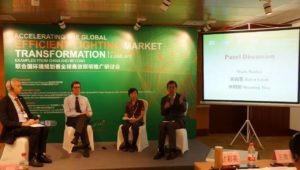
Over 100 participants representing the United Nations, international energy efficiency agencies, as well as Chinese certification bodies, research institutions and lighting manufacturers attended the seminar.
The event was organised with the Global Efficient Lighting Centre, a UN Environment Collaborating Centre and an accredited global facility that provides lighting testing, training, advice and quality control to developing and emerging countries.
China’s National Development and Reform Commission and Ministry of Industry and Information Technology opened the event, speaking on how they are promoting innovation in lighting industry and also on the importance of energy efficiency standards. Manufacturers, including Philips Lighting and Osram, presented on fast technology shift to LED lighting and business models to support countries in the market transformation.
In addition, United for Efficiency and the Global Efficient Lighting Centre announced the organisation of the second Global Efficient Lighting Forum in 2018. The first Forum convened in Beijing in 2014, focusing on global market transformation to energy-efficient lighting such as LEDs.
Effective policy measures that transform markets to higher energy efficiency such as minimum energy performance standards are still needed in many developing countries. LED lighting is now one of the most cost-effective energy-efficient products. Countries can save billions of dollars per year by making the switch to LEDs.
Electricity for lighting accounts for about 15 per cent of global power consumption. High-efficiency lighting technologies offer up to a 90 per cent improvement in energy efficiency compared with conventional lighting technologies, while providing an equal or better quality of light.
This is because the incumbent products include old technology such as incandescent lamps, which are based on a 125 year-old technology and are now replaceable with widely available LED products that can cut power use by 80 – 90 per cent.